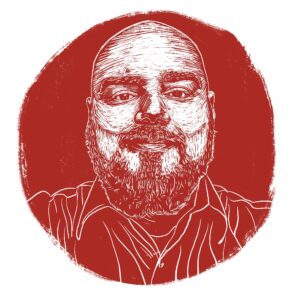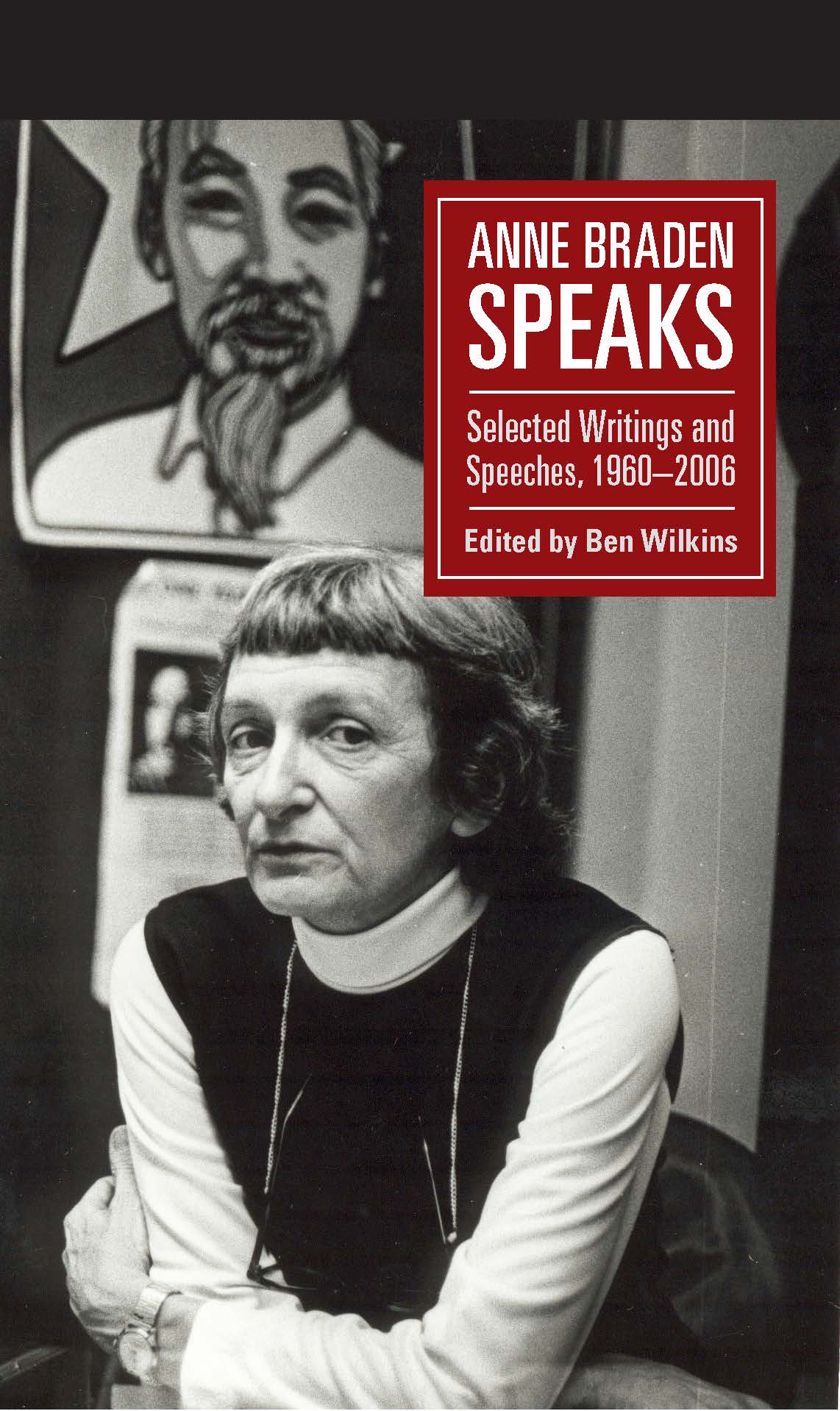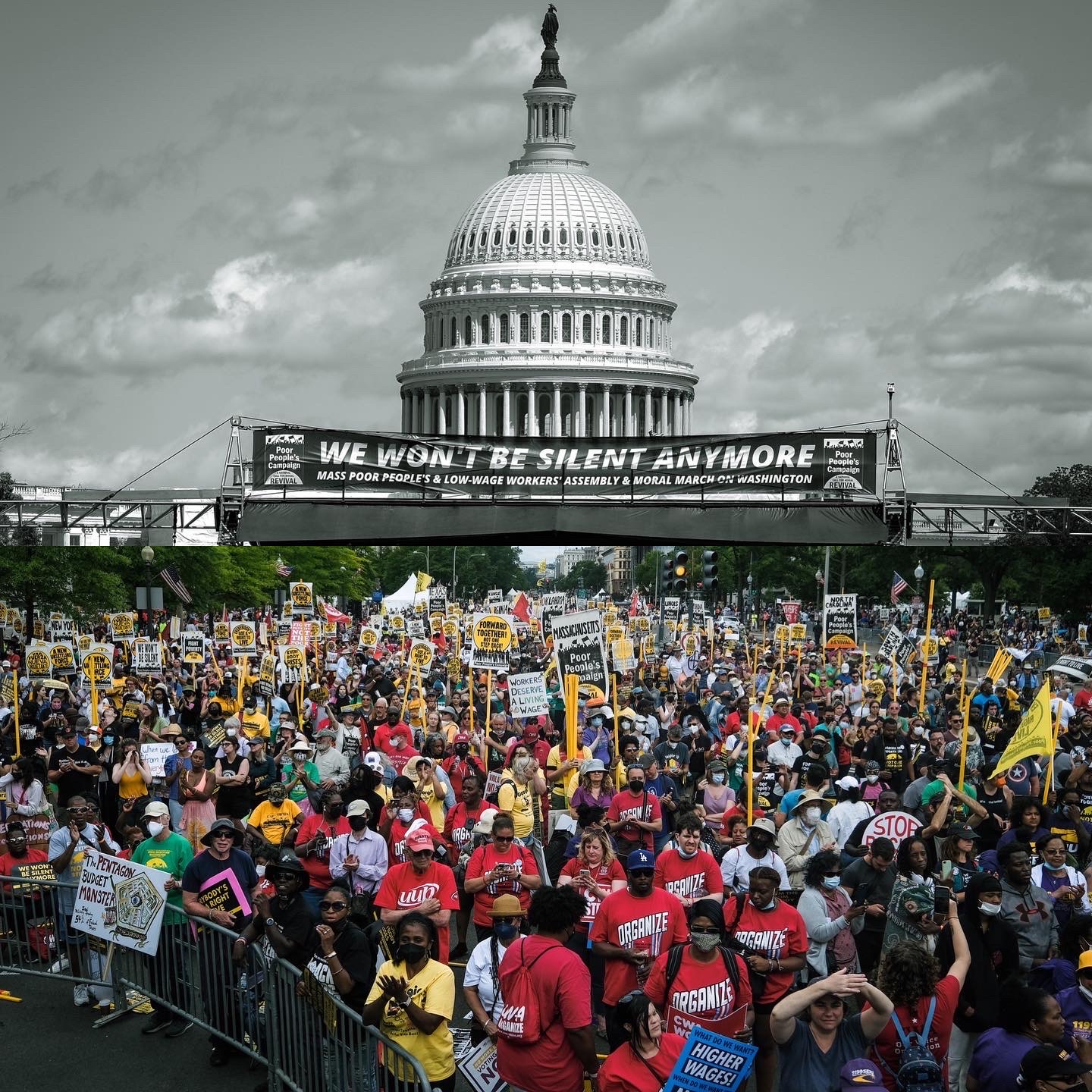Daniel Jones: Hi, Ben, great to be with you again. You’ve edited a volume that has just come out called Anne Braden Speaks: Selected Writings and Speeches, 1960-2006. Over these past couple of decades that you’ve been reading and studying Braden, how has she impacted and influenced the work that you do?
Ben Wilkins: There’s a whole lot of ways but I’ll just share three major ones. One is the role of the South in political development in the United States, and the role of what Braden called the Southern Freedom Movement: the movement for justice and democracy and equality among Southerners, especially the working people of the South. I think that is number one – the critical nature of the role of the South.
Number two is the way that her analysis of white supremacy and race, and its function in this country and especially in the South, is one of the most textured and deep analyses of race that is out there. It’s worth studying and developing not a surface-level but a deep understanding of how she understood the function of race in society.
Third, she came out of the trade union movement in the 1940s. That was where she first was politicized, in Louisville, Kentucky, with the farm equipment workers. This has been especially important for me as a labor organizer: her understanding the deep role of the trade union movement, and the necessity of building it in the South and linking it to the broader movement for widespread social change.
She was a white woman raised in a middle-class family in Alabama, a family that she said was quite racist. The work she was engaged in for her whole life was building a multiracial – in those days it was called interracial – movement, specifically of poor and working-class people in the South. The role of SCEF (Southern Conference Educational Fund) and SOC (Southern Organizing Committee for Economic and Social Justice), the two main organizations she led over the years, was to build those alliances, specifically by focusing on organizing poor whites in the South to be in struggle with the civil rights movement, with the trade union movement, and with movements of the ’70s and ’80s.
Her real work was about how you build a coalition of the poor in the South. She would oftentimes quote this line from the book Black Power by Kwame Ture, who was then known as Stokely Carmichael, that the only coalition acceptable to the Black Power movement was with poor whites. This is not the way that book is often thought of. So even in the Black Power movement, there was a real understanding among many that there had to be this alliance built with poor whites. So that was her work, establishing that alliance and building a multiracial movement.
It’s important to have an understanding of where that analysis comes from, because she didn’t think of these ideas out of thin air. She was deeply steeped in Marxist thinking, and was specifically mentored by William Patterson, who was a leader in the Communist Party. He was a leader of the Civil Rights Congress in the 1950s, which was when she met him and was involved with the Civil Rights Congress in Mississippi. Their analysis came out of decades of collective study about the role of the Black Belt, about the economic function of white supremacy, and about the connection between slavery and capitalism.
She had a materialist analysis of how white supremacy was really a form of class domination. And so she never separated race and class, and she insisted on the two things being totally connected. I think that part of her analysis is not as widely understood as some of the popularizations of who Anne Braden was.
DJ: Could you say a little more about how she understood what it meant to squarely take on white supremacy in that way and not sidestep it?
BW: It’s not about getting into a debate with people: that alone doesn’t work. People’s ideas change through struggle, is what she thought.
Probably the best example is the Gulf Coast Pulpwood Association, which was a union of pulpwood haulers in the Deep South, mostly in Mississippi, Black and white. We’re talking about Mississippi, of course – many of those white workers had very, very racist ideas. But through struggle, they learned how to build unity. People like Tonny Algood, Bob Zellner and the other organizers on the campaign were building that work. Countering racist ideas was an important aspect of their organizing, but they didn’t do that by knocking on pulpwood haulers’ doors trying to debate them on racism. They were saying, “Hey, you’re going through this situation, you’re struggling. Black workers are struggling with the same set of conditions. The only way you can win is to build unity.”
They were organizing around unemployment in Appalachia, in Kentucky. They took a huge delegation of poor whites from Appalachia to Resurrection City during the Poor People’s Campaign in 1968. They also organized tenant associations in the Gulf Coast in the 1980s. Braden’s various organizations did all this kind of work. And there were many different struggles. Sometimes it was a labor struggle, sometimes it was a housing struggle, sometimes it was a struggle around unemployment, but always the thread was building unity around concrete struggles.
DJ: You’ve gathered some of Braden’s key writings over the decades and packaged them and made them available to organizers, activists, and revolutionaries today. Why did you think it was worth doing this?
BW: Her life’s work was building a united, multiracial, class-based movement that united poor whites and Black folks. It was a very bifurcated Black and white society in the South at that time. I think she would fully agree that today it’s about bringing indigenous folks and Latinx folks together as well, in building the unity of the poor and the unity of workers. That was her project. And that project is even more valid, necessary, and urgent today than it was back then.
So bringing her powerful understanding of the need for that kind of movement to today’s audiences is critical, and it’s timely. She was struggling with many of the same issues that we struggle with. One was the rise of these ultra-reactionary, racist political elites in the South. In her time, that’s who was in full control. She called it a police state. There was no semblance of democracy. Black folks literally couldn’t vote. And that’s the same kind of forces that we’re contending with today. Her answer to defeat that power was to build unity.
She also had a textured understanding of how to build a popular movement. And she talked about the importance of faith. She was raised in the Episcopalian Church and even though she denounced pretty much every element of her upbringing – the white supremacy, the patriarchy, the Jim Crow society – she never abandoned her religion, which I think is very interesting. Even though she was raised in this racist white church, her understanding of Christianity allowed her to build bridges with the Black Freedom Movement in the ’60s. The first chapter in the book is a letter she wrote to Dr. King. She speaks powerfully in very Christian terms, trying to push him and encourage him to do the right thing and stand up to red baiting, even if it meant losing respectability in certain circles. Her approach to movement building, her understanding of the role of faith, her understanding of the South, and her understanding of building unity are all urgent today.
DJ: In the end, such a unified movement did not come together in the South in her lifetime. In the book, I thought it was important that she was transparent in saying, ‘Look, we’re trying to do something in organizing poor Southern whites that has not really been done, and we’re probably going to do a lot wrong. But the important thing is to try and to draw lessons.’ What do you think are some of the lessons that she drew, looking at the successes and failures of the projects that she was involved in and related to?
BW: At one point she says that the unity of the poor, building this movement of poor whites and blacks in the South, is the one thing that the power structure fears the most. That was the most insightful lesson. It was the main thing that really strikes fear in the heart of the rich and powerful.
The second thing is, you can’t sidestep the question of race. You have to go through it. You can’t build a movement that separates people by race. But in the act of building the unity of the poor, you have to directly address racism and white supremacy, in terms of the way it appears in the mental terrain of the folks who were in the movement and also in the way the economy functions and the way the political system functions. I think that’s something that the Poor People’s Campaign has been really sharp on and is carrying on those lessons from Braden.
Another lesson comes through in the chapter “Education for Building a People’s Movement.” where she has a compelling piece on the development of the movement from the 1960s into the ’70s and ’80s. She’s writing in the early ’80s, and she generalizes and says that in the 60s the moral fire of the movement was there. There was a righteousness to it. There was the March on Washington and all this activity happening in the early ’60s, the height of the Civil Rights Movement. This moral fire captivated the hearts and minds of the public, including in the South, including among white folks. And in the ’70s, there was a really strong focus on having a hard-edged materialist analysis of economic facts of the relations of production and technology, and a comprehensive understanding of the economy from a very Marxist lens. But they lost the moral fire. They lost the righteousness that captured the hearts and minds of people. So she said, we have to be able to bridge those two strands into one tendency and one approach to movement building. You have to have moral fire and you have to have materialist analysis. That simple insight is really important. It’s very rare in my experience, when someone can bridge that gap and do both things at the same time.
DJ: Braden’s political career saw the movement go through lots of ups and downs, periods of real advances and possibility and then really painful reaction. A lot of projects that she put time and energy into fell apart in different ways, but she stuck with it. What can we learn from that experience?
BW: The first thing that’s not really a lesson is just that it’s very peculiar about her. Most people who are in political struggle, who are activists and organizers, are recruited into struggle or become part of movements during upsurges. And just because of her age and when she came in, she became a part of the struggle in 1947 right as a great downturn was happening. That’s an interesting time to enter the Left movement – she’s seeing Taft-Hartley get passed, she’s seeing the Iron Curtain speech, she’s seeing the CIO get purged of all its left-wing membership. All of these things are happening right when she’s entering into the movement.
It may have allowed her to have this link to the movements of the ’60s that very, very few people who were of the movements of the ’30s were able to establish. She was one of those few really direct links.
Another thing is that Braden became famous during the anticommunist purges in the ’50s, because she was tried along with her husband for sedition in 1954. There were two things they could have done. One, they could have denied being communists, which many good people did just to save their ass. But what she saw was that that didn’t work. It was not going to change the way they were talked about. It wasn’t going to change the way the state came after you. So she and her husband Carl refused to play that game. They went on the offensive against McCarthyism, and they won.
Throughout her life she would refuse to say whether she was or was not a communist. That was a McCarthyite question, in her opinion. She went on the offensive and rather than making it a defensive struggle about “am I or am I not a subversive”, she made it into an offensive struggle about the basic right to free speech in this society. I think that was a very important insight in these periods of reaction; not to retreat, but to stay on the offensive at all times.
The second thing is to have a concrete analysis of the conjuncture and to base your strategy on that. In that respect, the most important piece in the book is “The Southern Freedom Movement in Perspective,” which essentially is a very long conjunctural analysis. She is reading the terrain for an audience, and in so doing is able to formulate strategy out of that. The year she wrote it was 1965. It was in that year that SCEF made a very important strategic shift towards a heavy focus on organizing poor whites around wide ranging social and economic issues. Previously, their focus had been solely on integration. That was the main struggle in their analysis before 1965. What Braden and SCEF said in the ’50s and early ’60s was that we can’t create far-reaching change in society without first breaking the back of Jim Crow.
Her analysis in ’65 was that now, as the basic demands of the civil rights movement were being won, we have to broaden the struggle. We have to organize poor whites in a big, big way. We have to deepen the demands of this moment from being able to sit at a lunch counter and being able to vote – all really critical demands – to a whole critique of the socioeconomic underpinnings of the society. So that’s a second lesson: having a very clear, correct analysis of the moment that you’re in so that you can formulate strategy appropriate for the moment.
The third thing is the opposite, really. It’s understanding when you’re in a period of reaction and making analysis of how to retreat. In the ‘80s, at the onset of Reaganism and this reactionary turn, she again shifted a lot of the focus of her work.
DJ: These lessons raise the question of a Party as well and having an organization of revolutionaries that can organize the organizers. Where did she come out on this question of the need for a cadre organization or something that can play a leading role in a big movement? Do you see that in her work or her thinking?
BW: She didn’t talk much about that kind of thing in public settings, but I believe she thought cadre development was critically important. And I think the way that you can tell that is by looking at how focused she was on mentorship and political education. There are hundreds of people in the South still around today who directly went through this cadre development process with her, really at her feet.
And SCEF did function as a cadre organization in many respects, especially during the late 1960s and early 1970s. They would recruit the best and brightest folks from the Southern movement into their orbit and then have coordinated approaches to the work. They were working on all different fronts. They were active in the anti-war movement, they were doing GI organizing, they were organizing trade unions, they were doing all kinds of stuff. They were transmitting a comprehensive analysis, doing political education, and really building that core of committed organizers who were leading the struggles.
So I think they functioned in many ways as a cadre organization for the South, even learning the lessons of Lenin from Where to begin? and What is to be done?. They used this newspaper, The Southern Patriot, not just as a source of information, but also as an organizing tool. They used it to cultivate organizers. Just the act of saying to somebody who’s organizing around a miner strike in Kentucky, “Hey, could you write three paragraphs about what you’re doing for the paper?” That in itself is an act of political education and organizing. So there were many lessons that I think she pulled away from party-building projects over the years.
DJ: I appreciate you directing us toward the question of leadership development. Is there anything more you want to say about that? We understand that anybody trying to be a leader in this movement needs to be able to develop other leaders.
She always had a really principled approach to building the movement with people. And she was incredibly gracious and patient with people and really respected and learned from everybody she came in contact with. So her style of mentorship, education, and leadership development was always about learning with people.
And she was not afraid of conflict. There are a few pieces in the book, but there’s all kinds of stuff out there in the archives, where she would just write someone a letter and say, “I do not agree with this thing that you said, and here’s why.” That’s pretty rare. But she did it in such a way where I’ve never heard about anybody in the movement having a bad thing to say about Anne Braden. She was able to build that kind of confidence and trust from people, even when they had really, really sharp disagreements.
Her political style was very distinct. It’s very easy to succumb to sectarianism and she was able to be principled, forthright, take a hard line, and have a radical analysis, without being bound to sectarianism.
Another thing is that she was always seeking to have a deep understanding of history and always teaching history at every moment. You see that, especially in her personal letters, and in the memos she wrote to different organizations. She really took being a thinker seriously and saw that as a vital part of building a movement. It wasn’t just about knocking doors. It wasn’t just about going out on the picket line, although she did a whole lot of that. It was about stepping back and viewing the landscape and trying to figure out what is this moment we’re in? And how did we get here? She was always taking people back to that.
Al McSurely one time said to me that she always forced people to sit down and think. So she had that mentality and that approach to leadership development. She once said, “I don’t see myself as a leader, I see myself as a soldier in the trenches.” And practically all she ever did was try to identify new soldiers to join in the trenches. She was always trying to build the nonviolent army, so to speak.
DJ: I want to return to something you mentioned earlier, which was Braden’s continued work in the ’70s and ’80s and her work in the National Anti-Klan Network. It’s a period that isn’t looked at as much, but Braden described it as a time when the prospects for building multiracial unity of the poor were greater than ever. What are some lessons from that experience for today?
BW: Right. She wrote about that in the mid ’70s. Think about that moment in history. With the benefit of hindsight, you can see just how correct she was in that moment in the mid ’70s. There were a lot of people in that moment who thought we were marching towards revolution. Basically what she was saying is that we’re in a contradictory moment. We’ve won all these tremendous victories around civil rights, voting rights, all these social programs. We’ve won all these victories, and there’s been all this movement, and we were even able to force the U.S. government to exit from Vietnam. And now we really are in a moment, because of this past 10 or 15 years of struggle, where we can go even further, and we can build unity and really take the next step toward fundamental revolutionary change.
But she also saw that there was a conscious effort on the part of reactionaries to turn back the clock to defeat the movement. And the way that they will do it is through racial division. In the 70s she writes that that’s the way the movements are being defeated and have in the past been defeated. And so she really saw this rise of Christian nationalism, this rise of Reaganism, and white supremacy as an effort on the part of the ruling class to defeat the movements of the ’60s.
She said that the critical step to avoid that defeat is to build unity among the poor, especially in the South. She had a really clear understanding of where things could head if this didn’t happen. And they did indeed head that way, with the election of Reagan and with the rise of all of these far-right groups in the 1980s. They launched a vicious assault on poor people all across the country. And it was really done through stoking that division.
DJ: We should end by encouraging everyone to read the book! There are so many lessons there. Thanks so much, Ben, for the conversation, and I look forward to digging in more once more people have read it and are digesting what it all means for today.

Ben Wilkins has been an activist and organizer in social justice struggles for over 20 years. He began his work as a labor organizer in Detroit, Michigan, where he worked for the healthcare workers union. Since 2013, he has been the director of Raise Up the South, a union of low wage workers based in North Carolina. He is also the editor of the book Anne Braden Speaks: Selected Writings and Speeches, 1960-2006 (Monthly Review Press).


